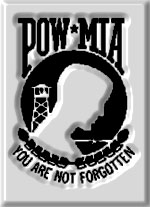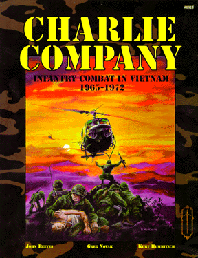Atomicat's
Charlie Company
Rules Page 1
Please Visit: Daniel Raymond Phillips Memorial |
 |
Please Visit: Daniel Raymond Phillips Memorial |
Please Visit: Daniel Raymond Phillips Memorial |
 |
Please Visit: Daniel Raymond Phillips Memorial |
| Resources | Rules |
|---|---|
The movement rules for Charlie Company are fairly complete, however they don't adequately cover movement over rough terrain, such as vertical surfaces; or movement over obstacles, such as walls. Here are some quick and dirty rules to cover that type of movement.
Each obstacle should be measured for its height. Any obstacle less than 1/4" in height is not considered as an obstacle in these rules; simply use the existing movement rules for obstacles under 1/4". Movement over a 1/4" high obstacle is each to horizontal movement of 2". If an obstacle is higher than 1/4" but less than or equal to 3/4", each 1/4" of additional height adds an additional 1" of movement cost. Obstacles higher than 3/4" add a 2" of movement cost for each 1/4" of height. These rules assume a scalable wall, cliff, or other obstacle. Terrain modifiers should not be applied to movement over obstacles.
The maximum height that may be scaled typically depends on the surrounding terrain. In cleared, rubber plantation, elephant grass, brush, or swamp areas, a maximum of 1 1/2" is recommended. Likewise, in forest 2", dense forest 2 1/2", and jungle 3" are recommended.
Any height of 1/2" or more may be scaled with the use of ropes or ladders at the cost of 1" per 1/4" of height.
| Movement Cost for Vertical Obstacles | ||
|---|---|---|
| Height of Obstacle | Movement Cost | Max Recommened Scalable Height for Terrain |
| 1/4" | 2" | |
| 1/2" | 3" | |
| 3/4" | 4" | |
| 1" | 6" | |
| 1 1/4" | 8" | |
| 1 1/2" | 10" | Clear, etc |
| 1 3/4" | 12" | |
| 2" | 14" | Forest |
| 2 1/4" | 16" | |
| 2 1/2" | 18" | Dense Forest |
| 2 3/4" | 20" | |
| 3" | 22" | Jungle |
Charlie Company is, admittedly, a very simple game. The rules are simple and uncumbersome. That is what draws many players to the game. However, for an added level of realism and tactics, these rules for American machine guns may be used. American machine guns (LMG, BAR, M60, MMG, HMG) deployed with loaders may use the typical machine gun techniques of grazing fire and concepts like the beaten zone to increase the damage they do.
To gain the grazing fire bonus the MG must be firing upon an enemy squad that is within 20" of the MG, on the same level as the enemy squad, deployed with a loader, under combat order, and cannot move during the turn in which grazing fire is used. If all of the conditions are met, the player may choose to emply grazing fire.
All units that moved during the movement phase of the current and within a 45° cone of fire out to 20" are effected as if they were the only squad being hit by that MG. In addition a hit is scored on 4, 5, or 6. If firing in a close combat round, a 3, 4, 5, or 6 is a hit.
To gain the beaten zone the MG must be deployed with a loader and under combat order. Add 1D
for each enemy figure in the beaten zone. Determine the length of the beaten zone by measuring
the range to the center of the zone and consulting the chart. The beaten zone must be placed
lengthwise along the LOS between the MG and the target. The beaten zone is always 1" wide. As
with grazing fire, if the beaten zone extends to more than one squad, roll against each squad
individually as if it were the only squad coming under fire by that weapon.
| Range | 1" | 2" | 5" | 10" | 20" | 50" | 100" |
|---|---|---|---|---|---|---|---|
| Length of Beaten Zone | 0" | 1" | 2" | 3" | 4" | 5" | 6" |
| Weapon | Min Range (Tabletop) | Max Range | |
|---|---|---|---|
| (Metric) | (U.S.) | ||
| 60mm Mortar | 45"* | 2.5 km | 1.5 mi |
| 75mm Howitzer | none | 9.5 km | 6 mi |
| 81mm Mortar | 21" | 5 km | 3 mi |
| 82mm Mortar | 100" | 3 km | 2 mi |
| 105mm Howitzer | none | 13 km | 8 mi |
| 4.2" Mortar | 385" | 7.5 km | 4.5 mi |
| 120mm Mortar | 250" | 5.5 km | 3.5 mi |
| 155mm Howitzer | none | 26 km | 16 mi |
| 8"(203mm) Howitzer | none | 19 km | 12 mi |
| *May be fired at less than 45" in direct fire | |||
To determine rain and mud, use the following table. Determine the month and then check for heavy rain 1d10 (1-10), a roll less than or equal to the number shown indicates heavy rain; you will not be able to receive tactical air support, no helos may operate, expertise is reduced 1/2, roll 1/4 of all combat dice, and maximum line of sight is reduced to 1/2 of normal, with maximum line of sight in clear terrain being 40". If the check for heavy rain fails, check for light rain in the same way, a roll less than or equal to the number indicates light rain; you will not receive tactical air support and expertise is reduced 1/4. Always check for mud, a roll lower than or equal to the number shown indicates; mud lessens the effects of supporting fire by 1/2 and doubles normal movement costs for foot troops moving up or down hill. During monsoon season, June through September, helicopters and tactical air support will not operate, regardless of the local weather conditions.
|
| |||||||||||||||||||||||||||||||||||||||||||||||||||||||||||||||||||||||||||||||||||||||||||||||||||||||||||||||||
This system has been playtested from the earliest games in my An Khe campaign. It seems to work fairly well, but like all point-based systems, it can be abused by players if the GM is not careful. Each commander earns points for enemy killed and friendly casualties in his command. So a sergeant would get credit for any kills by his squad as well as any wounded or killed mebers of his squad. A platoon leader would get credit for any kills by his platoon, as well as all casualties in his platoon. So all casualties and kills may be scored multiple times, depending on the length of the chain of command. However, kills and casualties should not be scored multiple times within the same command level; i.e. two sergeants shouldn't be able to score the same kill. If a kill is ambiguous, award fractional points to each commander.
The GM should feel free to award points based on partial completion of the mission. Typically,
if the mission isn't completed, a maximum of 13 VPs should be awarded. Every leader may be
awarded up to the maximum of 25 VPs for a successfully completed mission. It is not a shared
pool of victory points. However, if a commander shirked his duty or did something detrimental
to the cause of the mission, he may recieve less than the full amount.
| Conditions | Victory Points |
|---|---|
| Successful Completion of Mission | +25 |
| Per American Killed | -20 |
| Per American Seriously Wounded | -10 |
| Per Enemy Killed | +1 |
The sniper rules in Charlie Company (8.45) are fine for most conditions. However, for more realistic rules for American snipers, the following rules are recommended.
Each sniper is a specially trained marksman who, in addition to having normal expertise
rating, also has a sniper skill rating. Determine expertise normally. Determine sniper skill by
rolling 3d6 and consulting the following table.
| Total Rolled | 3,4,5 | 6,7,8 | 9,10,11 | 12,13,14 | 15,16,17 | 18 |
|---|---|---|---|---|---|---|
| Sniper Skill | 4 | 5 | 6 | 7 | 8 | 9 |
In combat, an American sniper may attempt to shoot at any target he can see, regardless of range. Each combat turn, he rolls 1d6 to see if a shot is available. On a roll of a 6, which indicates that a shot is available, the sniper may fire by rolling 1d10 (1-10). A roll less than the sniper skill indicates a hit and kill. A roll equal to the sniper skill requires an additional 1d10 roll. A roll less than or equal to the sniper skill indicates that the target has been hit and seriously wounded. A roll higher than the sniper skill indicates a clean miss.


